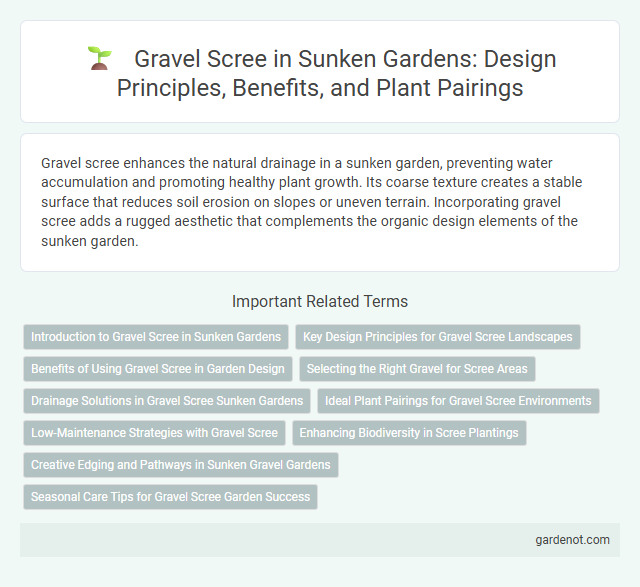Gravel scree enhances the natural drainage in a sunken garden, preventing water accumulation and promoting healthy plant growth. Its coarse texture creates a stable surface that reduces soil erosion on slopes or uneven terrain. Incorporating gravel scree adds a rugged aesthetic that complements the organic design elements of the sunken garden.
Introduction to Gravel Scree in Sunken Gardens
Gravel scree in sunken gardens serves as an essential landscaping element, promoting effective drainage and preventing soil erosion in lower-ground areas. This loose, coarse aggregate composed of small stones enhances soil stability while allowing water to percolate efficiently, supporting healthy plant growth. Incorporating gravel scree not only improves the garden's structural integrity but also adds a natural, textured aesthetic to the sunken garden environment.
Key Design Principles for Gravel Scree Landscapes
Gravel scree landscapes thrive on principles of naturalistic design, emphasizing drainage, texture contrast, and stability. Selecting angular gravel ensures interlocking particles for erosion resistance and water infiltration, while layering with smaller stones supports plant roots in the sunken garden environment. Incorporating native, drought-tolerant vegetation enhances biodiversity and complements the gravel's muted tones, promoting ecological balance and aesthetic harmony.
Benefits of Using Gravel Scree in Garden Design
Gravel scree enhances garden design by improving drainage and preventing soil erosion, making it ideal for sunken garden landscapes. Its porous nature facilitates water infiltration, reducing runoff and promoting healthy plant roots. Additionally, gravel scree requires minimal maintenance and adds a natural, textured aesthetic that complements various garden styles.
Selecting the Right Gravel for Scree Areas
Choosing the right gravel for scree areas in sunken gardens involves prioritizing durability, size, and color to enhance drainage and aesthetic appeal. Opting for angular gravel between 20-40 mm ensures stability and prevents displacement, while natural stone colors like gray, brown, or red blend seamlessly with garden elements. Proper gravel selection supports plant health by improving soil aeration and moisture control in sloped scree zones.
Drainage Solutions in Gravel Scree Sunken Gardens
Gravel scree in sunken gardens offers excellent drainage solutions by facilitating rapid water infiltration and preventing waterlogging. Its porous structure supports soil aeration while reducing erosion and runoff in sloped garden areas. Properly graded gravel scree enhances water management, maintaining healthy plant roots and structural stability in sunken garden landscapes.
Ideal Plant Pairings for Gravel Scree Environments
Gravel scree environments thrive with drought-tolerant, low-maintenance plants like sedum, saxifrage, and creeping thyme, which stabilize loose soil and add vibrant hues. Alpine plants such as arabis and dianthus complement the gravel texture while adapting well to rapid drainage and nutrient-poor conditions. Combining these species enhances biodiversity and creates visually appealing, resilient landscapes ideal for sunken gardens.
Low-Maintenance Strategies with Gravel Scree
Gravel scree offers a durable, low-maintenance ground cover ideal for sunken gardens, minimizing weed growth and reducing watering needs through excellent drainage. Its coarse texture supports soil stabilization on sloped areas, preventing erosion while enhancing aesthetic appeal with natural tones. Incorporating gravel scree in landscape design promotes sustainability by decreasing reliance on irrigation and chemical herbicides.
Enhancing Biodiversity in Scree Plantings
Gravel scree plantings mimic natural rocky habitats, providing ideal conditions for specialized alpine and drought-tolerant plants that enhance biodiversity. These scree gardens support a wide range of pollinators and small wildlife by creating microhabitats with varied moisture and temperature levels. Incorporating diverse native species in gravel scree improves ecosystem resilience and promotes ecological balance within sunken garden landscapes.
Creative Edging and Pathways in Sunken Gravel Gardens
Gravel scree offers versatile options for creative edging and pathways in sunken gravel gardens, enhancing both aesthetics and functionality. Utilizing natural stones or metal strips as boundaries creates defined, visually appealing edges that prevent gravel migration and promote clean lines. Integrating textured gravel varieties in pathways not only improves drainage but also adds contrast and depth to the sunken garden's overall landscape design.
Seasonal Care Tips for Gravel Scree Garden Success
Gravel scree requires regular seasonal care to maintain its drainage and aesthetic appeal, including removing debris and preventing weed growth during spring. In summer, occasional watering helps support any alpine plants without causing erosion or compaction of the gravel. Autumn cleanup involves raking fallen leaves and checking for displaced stones to preserve the structural integrity of the gravel scree bed.
Gravel scree Infographic

 gardenot.com
gardenot.com